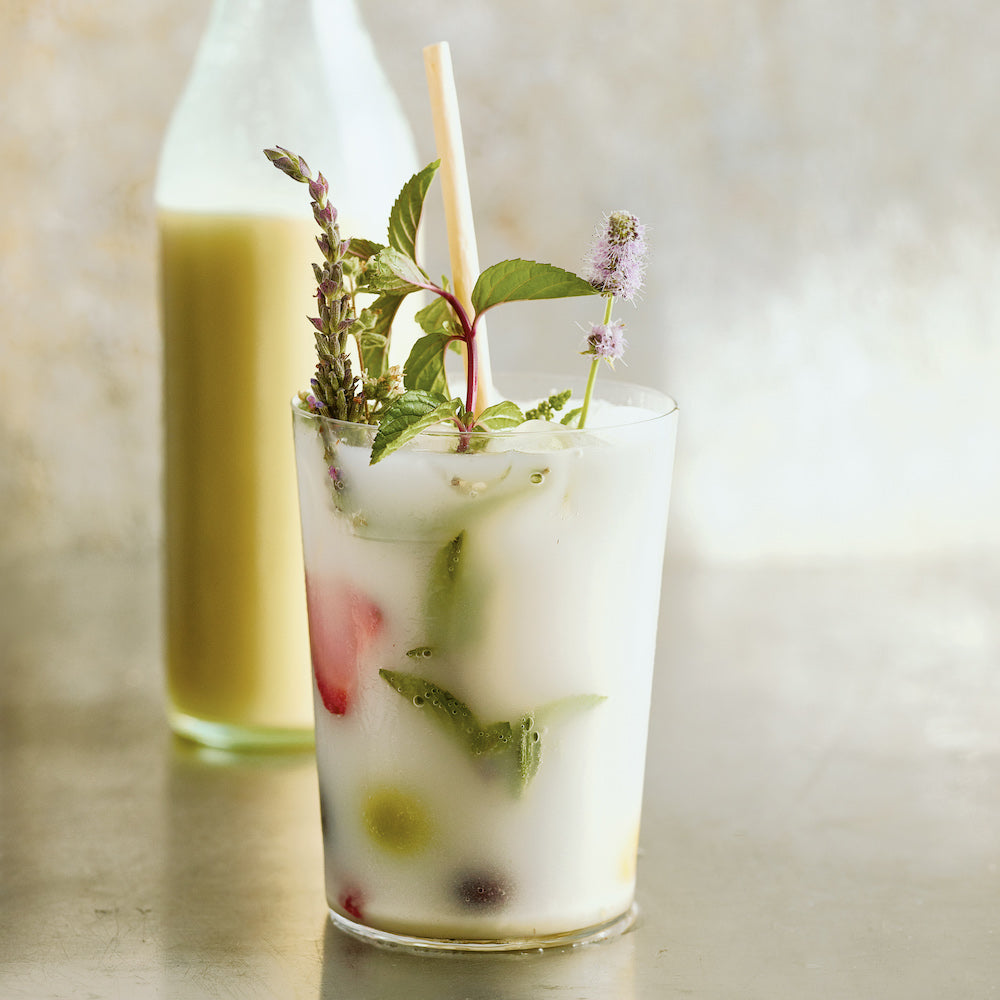Excerpted from Gazoz by Benny Briga and Adeena Sussman (Artisan Books). Copyright © 2021. Photographs by Dan Perez.
If you're looking for some new, refreshing drinks to make this summer, be sure to pick up a copy of the gorgeous new cookbook GAZOZ: The Art of Making Magical, Seasonal Sparkling Drinks by Benny Briga and Sababa author Adeena Sussman. If you’re not familiar with gazoz, it’s a popular Israeli-born seltzer drink now coming stateside by way of Benny’s cult-beloved Café Levinsky in Tel Aviv. His apothecary serves artful, irresistible concoctions of fruit, flowers and ferments crowned with bubbles to adoring fans.
We’re so excited to share their Halva Syrup recipe, from the book, with you!
INGREDIENTS
3 or 4 large ice cubes (see note below)
2 slices of fermented sour plums, plus 1 to 2 tablespoons of fermented sour plum syrup
1 to 2 tbs halva syrup
1 or 2 slices fresh yellow or red cherries
1 or 2 fresh strawberries
12 ounces (355 ml) sparkling water
Lavender and mint sprigs
Za’atar (hyssop) or oregano sprig
STEPS
1. Place the ice in a 12- to 16-ounce (360 to 475 ml) glass; spoon in the fermented sour plum syrup.
2. Add the fermented plums, fresh cherries and strawberries, and halva syrup on top.
3. Fill the glass with sparkling water, then garnish the top with the lavender, mint, and hyssop or oregano sprigs. Insert straw
and drink immediately.
Note: Though any ice cubes work well, cubes made with filtered mineral water or tap water that has been boiled and cooled will be clearer and more compact and will melt more slowly. Try to avoid crushed ice, which will melt quickly and dilute your beverage.
Makes 1 drink.
For the Halva Syrup
INGREDIENTS
¾ c (200 g) Seed + Mill Organic Tahini
1 c (200 g) sugar
1 c (240 ml) boiling water
STEPS
1. In a large bowl, whisk together the nut butter, sugar, and boiling water until the sugar has dissolved and the mixture is smooth.
2. Let cool to room temperature (if desired, strain through a fine-mesh strainer and discard any nut particles), then transfer to an airtight bottle or jar and refrigerate until ready to use. It will keep for up to 3 months.
Makes 2 cups (480 ml).
For the Sweet Fermented Sour Plums in Syrup
Start the fermentation process with clean, unblemished fruit of the highest quality, preferably organic, seasonal, and local. The fruit is the star of the show and should be treated as such, especially because once you’re done drinking your gazoz, you will most likely lift the juicy slices of fruit out of the glass and
eat them. The general rule for the fruit-to-sugar ratio is 70 percent sugar in relation to the weight of the fruit. Use that as your guide, unless otherwise indicated.
INGREDIENTS
1 heaping tbs (20 g) baking soda
1¾ lbs (800 g) whole sour plums (see notes below)
Lemon juice (optional)
1¼ lbs (560 grams) sugar
STEPS
1. Wash the fruit: Combine the baking soda with 2 quarts (2 l) cold water in a large bowl; add the plums, rub it well with a soft cloth to clean it, then transfer it to a separate large bowl filled with ice water; let the plums stand for 30 minutes to firm up.
2. Prepare the fruit: Slice the plums into 1-inch (2.5 cm) wedges (remove the cores, stems, and pits); you should end up with about 1½ pounds (700 g) cut fruit. If you’re using fruits that might turn brown (such as apples, pears, quince, etc.), drop them in a bowl filled with a mixture of 90 percent water to 10 percent lemon juice as you slice them.
3. Layer some of the plums in a roughly 1-quart (1 l) jar with a tight-fitting lid, then sprinkle with sugar. Continue to layer the plums and sugar until the jar is filled, leaving at least 1½ inches of headroom at the top of the jar.
4. Ferment the fruit: Seal the jar tightly and let it stand on the counter until a syrup has formed and the plums have softened and slumped slightly, 1 to 3 days, depending on the temperature of your kitchen; the sugar will dissolve more with each passing day. Open the jars daily to release any built-up pressure
from fermentation, and also to check the progress of the plums. This is the critical juncture; once you detect an aroma that is the essence of the fruit with a drop of sourness and acidity—sort of like cider—that is the time to decide if you want to let it ferment longer so it becomes more tart, or refrigerate the jar to slow fermentation. You can also dip a spoon in to taste the syrup, which will give
you a good indication of what’s going on in the jar.
5. When you are happy with the flavor of the plums, transfer the jar to the refrigerator. Use the fermented plums and its syrup within 2 weeks.
Note: To make 1¾ pounds (800 g) whole fruit, you’ll need 8 to 10 plums.
Note: When young, small, and rock-hard, most plums are sour and ideal for sweet fermentation. Persian sour plums can be found in farmers’ markets in late spring. If you don’t have access to a plum tree or farmers’ market selling sour plums, you could substitute whole umeboshi, pickled Japanese sour plums,
which are available at Asian markets and online at edenfoods.com.
Makes 3 to 4 cups (about 1 kg) plums with syrup.


